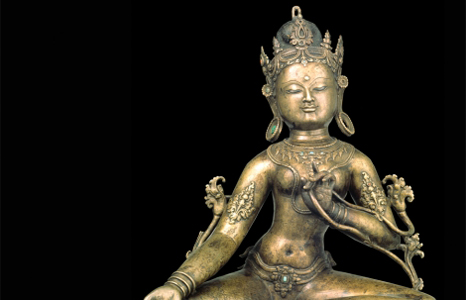Hands and feet have always played an important role as symbols in religion and religious art but perhaps never more poetically so than in Buddhism, as we discovered on a recent visit to the Rubin Museum of Art.
Situated in what was part of the original Barneys department store in Manhattan’s intimately elegant Chelsea district, the 9-year-old, 70,000-square-foot museum contains more than 2,000 objects that make it the premier institution of Himalayan art. Among those are works in which the feet and particularly the hands are articulated in such a way as to convey ideas.
“Mudras are loosely defined as hand gestures, from the Sanskrit ‘mud,’ meaning ‘bliss’ or ‘to please the gods,’ and ‘dhra,’ meaning ‘dissolving,’” says museum guide David G. Rosenberg, who grew up in New Rochelle.
The idea being in Hinduism, from which mudras are derived and later in Buddhism that a mudra “dissolves duality,” he says. Just as the hand connects partners and the body with space in ballet, so “a mudra brings together the deity being observed and the devotee.”
Mudras are used in East Indian classical dance, which has inspired martial arts; Hindu poojas (offerings); Tantric worship, a style of early Indian meditation and ritual; and yoga. There are set numbers in both Hinduism and Buddhism and countless variations, colored by the pose of the figure and its facial expression. The right hand represents the male, compassion and skillfulness; the left, the female and wisdom.
This is a complex subject that’s not always easy for Westerners to grasp. But Rosenberg says that we should think of it in terms of the hula dance or American sign language, in which “the hand gestures are symbols for something else.”
Perhaps the best way to understand mudras is to view some of the collection highlights with an expert guide like Rosenberg. We begin with one of the most beloved goddesses in Tibetan Buddhism – and one of the most beloved works in the Rubin – “Tara, Mother of All Activities.” This goddess of compassion is so beloved in fact, he adds, that when she comes off the floor – museums like to rotate their collections, showing only a portion of their holdings at a time – “Everybody says, ‘When’s Tara coming back?’”
The love affair with this 13th-century Tibetan brass work is instantaneous. Here is the essence of womanhood – strength, vibrance, sensuousness and intelligence – embodied in a graceful but voluptuous form that suggests the influence of Hindu art. This seated Tara’s also a wonderful example of hand and foot mudras. While the left leg is drawn up and in as if she were about to meditate, the right leg is off the seat, the foot flexed and the toes splayed.
“She’s ready to spring into action if we need help,” Rosenberg says. It is the foot of great protection.
Tara’s generously open right hand conveys “boon giving.” The left hand is more complex. The thumb and middle finger meet in a gesture of protection, wisdom and compassion. The index and ring fingers and pinky symbolize the three jewels – the Buddha, the ancient Indian prince Siddhartha Gautama, who renounced worldliness to find enlightenment; the Dharma, or teachings; and the Sangha, the Buddha’s original disciples.
Rosenberg moved on to several works depicting the Buddha, including “Shakyamuni Buddha,” a 16th century Tibetan painting made of pigments on cloth. The left hand is in a resting, meditative pose while the right points down. This “touching the earth” pose signifies the Buddha drawing the earth’s attention to his enlightenment. It is his signature gesture.
Early on, Rosenberg says, the Buddha – who is not a deity but “the Enlightened One” – instructed his followers not to depict him. But human nature being what it is, followers couldn’t resist having a likeness in their own image, much like the portraits of Jesus. In the Buddha’s case, these include depictions of his hands and feet.
Lamas (Tibetan monks) would also sometimes leave their actual hand and footprints on paintings as seals of approval.
This calls to mind the stars leaving their imprint in cement in front of the former Grauman’s Chinese Theater. Perhaps this is a measure of how far world culture has declined, from religious figures to movie stars, Rosenberg says.
But it’s also possible to look at this in a Jungian way – the hand and foot as cultural archetype. Hands and feet carry our identities. What they have to “say” is important.
Join the conversation: #wagbuddhist



